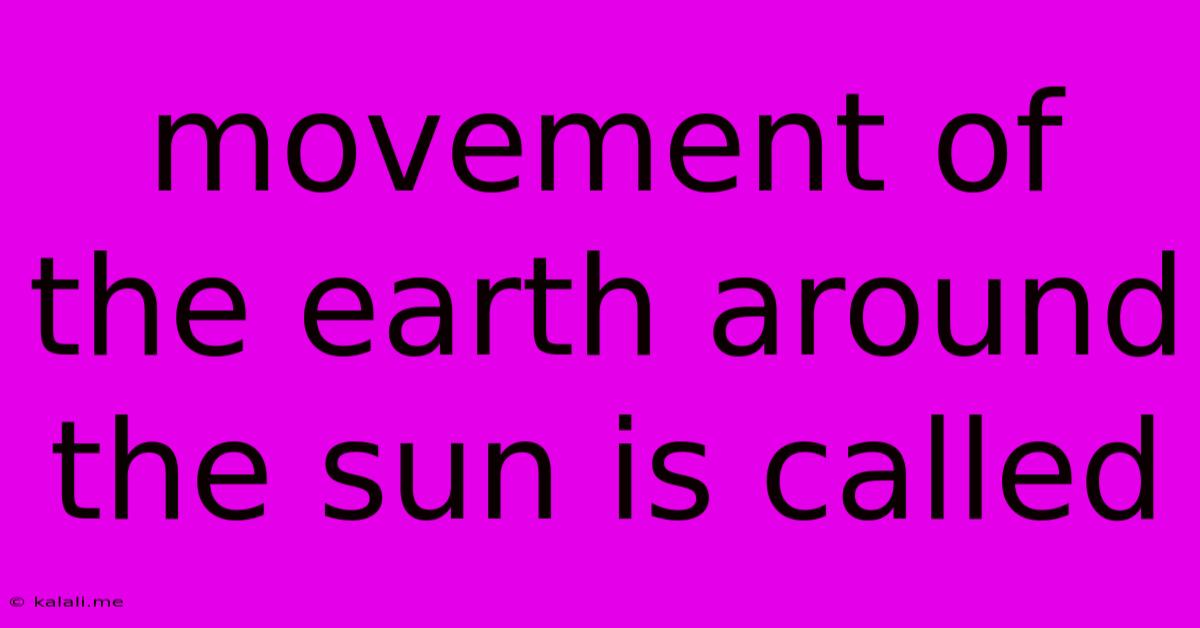Movement Of The Earth Around The Sun Is Called
Kalali
Jun 14, 2025 · 3 min read

Table of Contents
The Movement of Earth Around the Sun: Understanding Revolution and its Impact
The movement of the Earth around the Sun is called revolution. This continuous journey, taking approximately 365.25 days, is fundamental to our planet's climate, seasons, and even the length of our day. Understanding this revolution is key to grasping our place within the solar system and the forces that shape our world. This article will delve into the details of Earth's revolution, exploring its mechanics, consequences, and the fascinating science behind it.
What is Earth's Revolution?
Earth's revolution refers to its elliptical orbit around the Sun. Unlike a perfect circle, this orbit is slightly oval-shaped, meaning the distance between the Earth and the Sun varies throughout the year. This variation in distance, while influencing the intensity of solar radiation, is not the primary driver of our seasons. Instead, the tilt of Earth's axis plays a far more significant role.
This revolution isn't a simple, steady speed. Kepler's Laws of Planetary Motion dictate that the Earth moves faster when it's closer to the Sun (perihelion) and slower when it's farther away (aphelion). This variation in speed is subtle but crucial for precise astronomical calculations.
The Consequences of Earth's Revolution: Seasons and More
The most noticeable consequence of Earth's revolution is the cycle of seasons. As the Earth orbits the Sun, different hemispheres are tilted towards or away from the Sun. This tilt, approximately 23.5 degrees, causes variations in the amount of sunlight received by each hemisphere, leading to warmer summers and colder winters. The solstices and equinoxes mark the pivotal points in this cycle, defining the longest and shortest days of the year.
Beyond seasons, Earth's revolution also influences:
- The length of a year: The time it takes for one complete revolution defines our calendar year.
- Our perspective of the stars: As we orbit the Sun, the apparent positions of stars change throughout the year. This is used by astronomers to measure distances to stars via parallax.
- Tidal forces: While primarily influenced by the Moon, the Sun also contributes to tidal forces on Earth, and its position relative to the Earth and Moon affects the strength of these tides.
- Climate patterns: The Earth's position in its orbit influences long-term climate patterns and variations in solar radiation received throughout the year.
Understanding Orbital Mechanics: Gravity and Inertia
The fundamental forces governing Earth's revolution are gravity and inertia. The Sun's immense gravity pulls the Earth towards it, preventing it from flying off into space. Simultaneously, Earth's inertia, its tendency to continue moving in a straight line, keeps it from falling directly into the Sun. The balance between these two forces results in the stable, elliptical orbit we observe.
Beyond the Basics: Exploring Further
The study of Earth's revolution goes beyond simple orbital mechanics. Scientists continuously refine our understanding through precise measurements of Earth's position, velocity, and the influence of other celestial bodies. This research provides crucial insights into our planet's past, present, and future, contributing to our understanding of climate change, long-term environmental trends, and our place within the vast cosmos. Understanding the seemingly simple movement of Earth around the Sun opens doors to a deeper appreciation of the intricate workings of our solar system.
Latest Posts
Latest Posts
-
What Is The Smallest Unit Of Data In A Computer
Jun 14, 2025
-
Resistance Is Measured In A Unit Called
Jun 14, 2025
-
Which Is The Largest Satellite Of Solar System
Jun 14, 2025
-
Thymine Is Replaced By Which Nitrogen Base In Rna
Jun 14, 2025
-
Identify The True Statements About Colloids
Jun 14, 2025
Related Post
Thank you for visiting our website which covers about Movement Of The Earth Around The Sun Is Called . We hope the information provided has been useful to you. Feel free to contact us if you have any questions or need further assistance. See you next time and don't miss to bookmark.